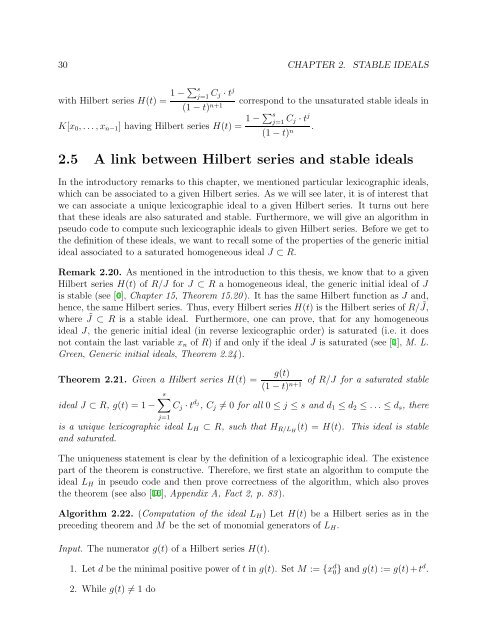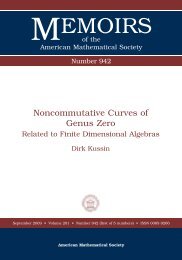University of Paderborn Department of Mathematics Diploma Thesis ...
University of Paderborn Department of Mathematics Diploma Thesis ...
University of Paderborn Department of Mathematics Diploma Thesis ...
Create successful ePaper yourself
Turn your PDF publications into a flip-book with our unique Google optimized e-Paper software.
30 CHAPTER 2. STABLE IDEALSwith Hilbert series H(t) = 1 − ∑ sj=1 C j · t j(1 − t) n+1 correspond to the unsaturated stable ideals inK[x 0 , . . . , x n−1 ] having Hilbert series H(t) = 1 − ∑ sj=1 C j · t j(1 − t) n .2.5 A link between Hilbert series and stable idealsIn the introductory remarks to this chapter, we mentioned particular lexicographic ideals,which can be associated to a given Hilbert series. As we will see later, it is <strong>of</strong> interest thatwe can associate a unique lexicographic ideal to a given Hilbert series. It turns out herethat these ideals are also saturated and stable. Furthermore, we will give an algorithm inpseudo code to compute such lexicographic ideals to given Hilbert series. Before we get tothe definition <strong>of</strong> these ideals, we want to recall some <strong>of</strong> the properties <strong>of</strong> the generic initialideal associated to a saturated homogeneous ideal J ⊂ R.Remark 2.20. As mentioned in the introduction to this thesis, we know that to a givenHilbert series H(t) <strong>of</strong> R/J for J ⊂ R a homogeneous ideal, the generic initial ideal <strong>of</strong> Jis stable (see [6], Chapter 15, Theorem 15.20 ). It has the same Hilbert function as J and,hence, the same Hilbert series. Thus, every Hilbert series H(t) is the Hilbert series <strong>of</strong> R/ ˜J,where ˜J ⊂ R is a stable ideal. Furthermore, one can prove, that for any homogeneousideal J, the generic initial ideal (in reverse lexicographic order) is saturated (i.e. it doesnot contain the last variable x n <strong>of</strong> R) if and only if the ideal J is saturated (see [4], M. L.Green, Generic initial ideals, Theorem 2.24 ).g(t)Theorem 2.21. Given a Hilbert series H(t) =<strong>of</strong> R/J for a saturated stable(1 − t)n+1s∑ideal J ⊂ R, g(t) = 1 − C j · t d j, C j ≠ 0 for all 0 ≤ j ≤ s and d 1 ≤ d 2 ≤ . . . ≤ d s , therej=1is a unique lexicographic ideal L H ⊂ R, such that H R/LH (t) = H(t). This ideal is stableand saturated.The uniqueness statement is clear by the definition <strong>of</strong> a lexicographic ideal. The existencepart <strong>of</strong> the theorem is constructive. Therefore, we first state an algorithm to compute theideal L H in pseudo code and then prove correctness <strong>of</strong> the algorithm, which also provesthe theorem (see also [16], Appendix A, Fact 2, p. 83 ).Algorithm 2.22. (Computation <strong>of</strong> the ideal L H ) Let H(t) be a Hilbert series as in thepreceding theorem and M be the set <strong>of</strong> monomial generators <strong>of</strong> L H .Input. The numerator g(t) <strong>of</strong> a Hilbert series H(t).1. Let d be the minimal positive power <strong>of</strong> t in g(t). Set M := {x d 0} and g(t) := g(t) + t d .2. While g(t) ≠ 1 do
















